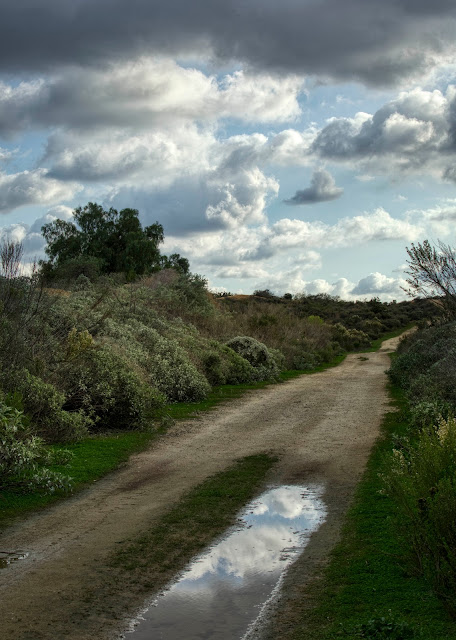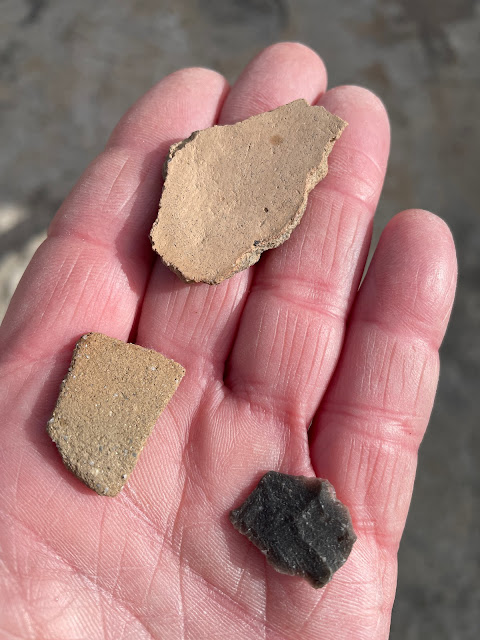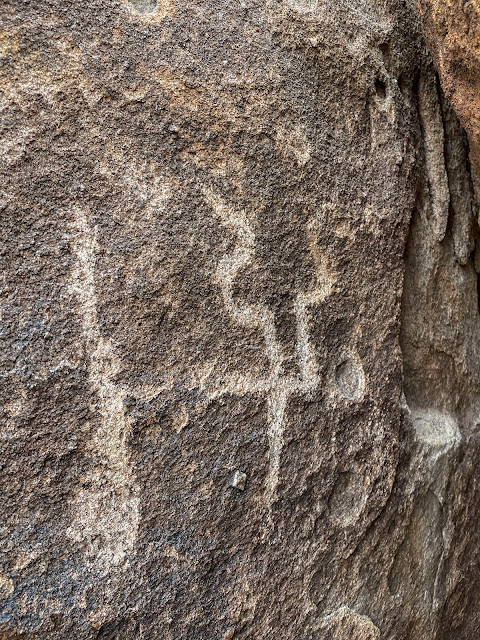It wasn't so much the distance (7-8 miles) that had me worried. It was the 1600' elevation gain. That's a lot for an old guy like me, and I joked with my hiking partner (who has summited almost every significant peak in the western US and for who this would be a "walk in the park") that he might have to push me up to Pushawalla. He laughed, but I told him I have serious concerns! As it turns out, after a tremendous amount of huffing and puffing, I made it. So pull up a chair and join me as I attempt this challenging and beautiful hike in Joshua Tree National Park!
 |
| Native American bedrock mortars. |
We spotted this weird buish rock with a pink stripe in the early part of our hike. It really stands out compared to the surrounding rocks. It would be fun to hear a geologist talk about this formation. Also, on the right side of this formation are the remnants of a paved road! Evidently, this wash was once used to travel up to the Pushawalla Plateau and down the other side to the Coachella Valley. Perhaps supplies were once brought in this way to the miners who once worked the area. Lots of history in these hills!
Mitch is anxious to get up to the Plateau, but I manage to talk him into following this old miner's road (can you see it?) and check out some of the historical remains. It doesn't add any extra mileage, but it does add some challenging terrain and requires extra time.
It wasn't long before we came across the remains of a stone structure. It's likely an old miner's cabin. This area is known as the Hensen Mining District. There are reported to be around 5-8 of these rock structures in the area.
There's a faint rocky rectangular outline with some rusty historic trash inside. Hard to say if there was a structure here.
There's a faint rocky rectangular outline with some rusty historic trash inside. Hard to say if there was a structure here.
 |
| We come across a small mine. |
 |
| The Park Service has it gated off. I wonder how far back it goes? |
 |
| Inside looking out. |
Cool find of the day! This is called a Chilean mill, and I had seen pictures of it and knew it was around here somewhere. Really pleased that I was able to find it. A Chilean mill is a big, heavy, round piece of concrete covered by a steel band on the outside (see photo below). It's used to roll over and pulverize rocks in the search for gold. There are only two of these in all of Joshua Tree National Park, and the second one is reportedly located somewhere in this area.
Two things caught my eye as we hiked past this pile of rocks. First is that the placement doesn't look natural. The boulders look like they were stacked here, although it would have taken tremendous strength and effort. Second was the old rusty chain. What possible use could it have??Another stone structure. This one is the best preserved with the highest walls of any we would come across. It's hard to imagine what it must have been like for the miners living for extended periods in this remote and rustic location.
 |
| Three-sided stone structure remains. |
Amazingly, we manage to find Chilean Mill #2! Mitch jokes that it looks like a headstone. The conversation goes downhill from there 😉
Further along on our hike, we come across the remains of a stone structure and some tailings. Someone must have been digging around here somewhere!
Sure enough, on the other side of the tailings, we find a mine. I think this might be the Pinyon Mine (sometimes called the Tingman-Holland Mine), or more accurately, an exploratory mine near the main mine, which has been filled in and no longer exists.
 |
| The view out. Hi Mitch! |
We press on, and things get very steep and I'm huffing and puffing so much I can't even begin to think about taking pictures. But finally we reach what feels like a plateau. Thank goodness, because my legs feel like spagetti noodles and aren't responding to commands from my brain.
 |
| The views from Pushawalla Plateau are wonderful! |
 |
| That's the Salton Sea |
 |
| Mt. San Gorgonio on the horizon. |
This is one of the views that most impressed us. The Pinion Pine in the foreground, with Mt. San Gorgonio in the background, makes for a wonderful photo. I could see the wheels turning in Mitch's brain as he said "how incredible would it be to be up here for the full moon setting over snow-covered San Gregornio, with that Pinion Pine in the foreground?" I could picture the photo in my minds eye, and yes, it would be incredible. Unfortunately, an impossible shot, because it would require making this very challenging hike in the dark in order to get up here a little before moonset (and sunrise). Impossible and foolhardy. Impossible??





































.JPG)

.JPG)












.JPG)
